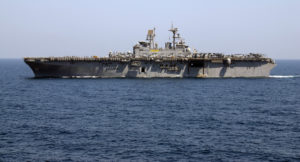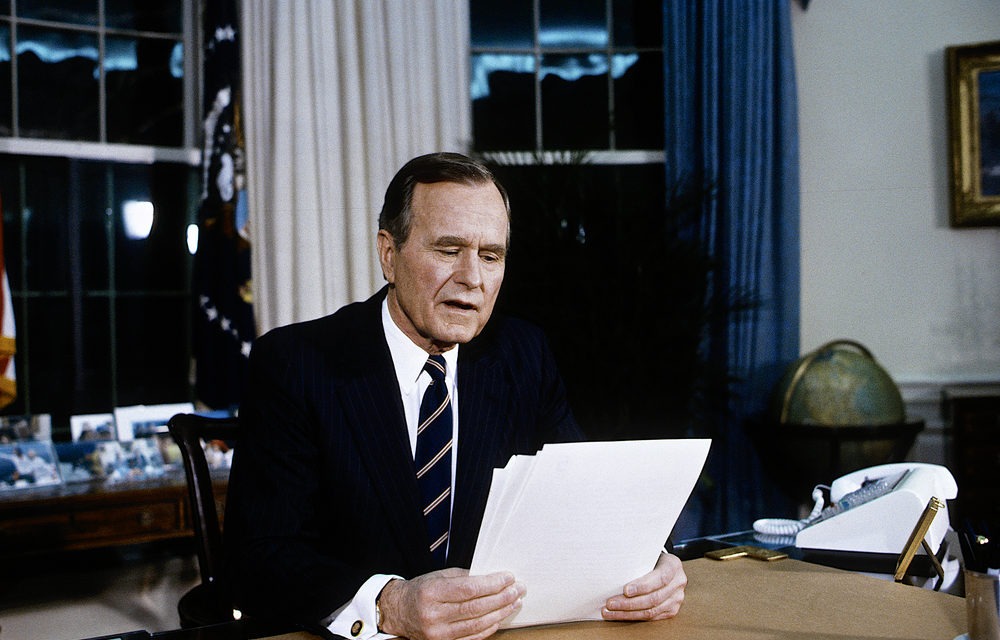Start of Persian Gulf War was Punctuated by ‘Shock and Awe’ Bombing
On Jan. 16, 1991, 30 years ago this year, the Persian Gulf War started when President George H.W. Bush, in a speech from the Oval Office, announced the start of Operation Desert Storm. The attack featured the “shock and awe” precision bombing of Baghdad by U.S. F-117 Nighthawk twin-engine stealth aircraft.
In response to Iraq’s invasion and annexation of Kuwait, coalition forces from 35 nations led by the United States — including Saudi Arabia, Syria, and Egypt — pushed the Iraqis out of the tiny oil-rich country.

An Amphibious Assault Ship cruises the waters of the Persian Gulf
When Iraqi dictator Saddam Hussein had invaded Kuwait the previous August, Bush said: “This will not stand.” He had the backing of Margaret Thatcher, the British prime minister, who told him in a phone call, three weeks after the invasion, “Remember, George, this is no time to go wobbly.”
They had disagreed about how to respond to oil tankers leaving Iraq in defiance of U.N. sanctions. The Bush administration, at the urging of Jim Baker, the secretary of State, sought a brief delay to win support from the Soviet Union through the U.N. Security Council — a collaboration that Baker later said marked the true end of the Cold War. Thatcher, for her part, urged prompt action.
Over the next six weeks, the Iraqis responded to the attack by firing 88 Scud missiles into Saudi Arabia and Israel, hoping to provoke a military response from the Israelis and thereby splintering the coalition.
After a five-week bombing campaign and a ground war that lasted 100 hours, Bush ordered an end to the hostilities, declaring Kuwait to be liberated. Two days earlier, on Feb. 26, Iraqi troops had begun to depart from Kuwait, after they had set 737 of its oil wells on fire.
A massive convoy of retreating Iraqi troops formed along the main Iraq-Kuwait highway. Although the Iraqis were retreating, they were bombed so heavily that their exodus became known as the “Highway of Death.” Hundreds and maybe thousands of Iraqi troops were killed or wounded. In armored columns, American, British, and French forces pursued retreating Iraqi forces over the border, moving to within 150 miles of Baghdad before withdrawing back to Iraq’s border with Kuwait and Saudi Arabia.
In all, 125 U.S. soldiers of the 540,000 deployed for the conflict were killed, with another 25 declared to be missing in action.
Bush encountered some criticism for having chosen to allow Saddam to remain in power instead of pushing on to capture Baghdad and overthrowing his regime. He defended his decision publicly by saying that going further would have fractured the coalition and privately by saying that doing so would likely have exposed the pursuing forces to a nerve gas attack.
Dick Cheney, the Defense secretary, said it wasn’t worth “getting bogged down.”
Source: “This Day in Presidential History,” by Paul Brandus (2018) and Politico
Image Sources
- Persian Gulf: Shutterstock
- President George H.W. Bush: Shutterstock





![Enrolling Now, Rewarding Careers Ahead [Sponsored]](https://ukenreport.com/wp-content/uploads/2024/04/COD_heroes_1-1385-2-440x264.jpg)

